ASX Glossary - Q: Difference between revisions
Jump to navigation
Jump to search
No edit summary |
No edit summary |
||
| Line 148: | Line 148: | ||
</head> | </head> | ||
<body> | <body> | ||
<table> | |||
<tr> | |||
<td class="term"> | |||
<a href="https://wiki.alsresume.com/index.php?title=Q_code" target="_blank" | |||
<tr | |||
<td class="term | |||
<a href="https://wiki.alsresume.com/index.php?title= | |||
style="color: #40E0D0; font-weight: bold; text-decoration: none; cursor: pointer;" | style="color: #40E0D0; font-weight: bold; text-decoration: none; cursor: pointer;" | ||
onmouseover="this.style.color='#ff4f01';" | onmouseover="this.style.color='#ff4f01';" | ||
onmouseout="this.style.color='#40E0D0';"> | onmouseout="this.style.color='#40E0D0';">Q-code</a> | ||
</td> | |||
<td class="description">Q-codes are standardized three-letter codes used in aviation communication and navigation. Originating from Morse code days, they convey specific meanings such as QNH (local pressure setting) or QFE (field elevation pressure). These codes simplify complex messages, especially during international and multi-language operations.</td> | |||
<td class="image-column"><img src="https://www.alsresume.com/wp-content/uploads/2025/02/Q-code.jpg" alt="Q-code"></td> | |||
<td class="description"> | |||
<td class="image-column"> | |||
</tr> | </tr> | ||
<tr | <tr> | ||
<td class="term"> | <td class="term"> | ||
<a href="https://wiki.alsresume.com/index.php?title= | <a href="https://wiki.alsresume.com/index.php?title=QDR_(Magnetic_Bearing_from_a_Station)" target="_blank" | ||
style="color: #40E0D0; font-weight: bold; text-decoration: none; cursor: pointer;" | style="color: #40E0D0; font-weight: bold; text-decoration: none; cursor: pointer;" | ||
onmouseover="this.style.color='#ff4f01';" | onmouseover="this.style.color='#ff4f01';" | ||
onmouseout="this.style.color='#40E0D0';"> | onmouseout="this.style.color='#40E0D0';">QDM (Magnetic Bearing to a Station)</td> | ||
<td class="description">QDM represents the magnetic bearing to a radio navigation station. It assists in direction finding and route alignment during en-route or approach phases.</a> | |||
</td> | |||
<td class="image-column"><img src="https://www.alsresume.com/wp-content/uploads/2025/03/QTM.jpg" alt="QDM"></td> | |||
<td class="description"> | |||
<td class="image-column"> | |||
</tr> | </tr> | ||
<tr | <tr> | ||
<td class="term"> | |||
<a href="https://wiki.alsresume.com/index.php?title= | <a href="https://wiki.alsresume.com/index.php?title=QDR_(Magnetic_Bearing_from_a_Station)" target="_blank" | ||
style="color: #40E0D0; font-weight: bold; text-decoration: none; cursor: pointer;" | style="color: #40E0D0; font-weight: bold; text-decoration: none; cursor: pointer;" | ||
onmouseover="this.style.color='#ff4f01';" | onmouseover="this.style.color='#ff4f01';" | ||
onmouseout="this.style.color='#40E0D0';"> | onmouseout="this.style.color='#40E0D0';">QDR (Magnetic Bearing from a Station)</a> | ||
</td> | |||
<td class="description">QDR is the magnetic bearing from a radio navigation station to the aircraft. It complements QDM and helps pilots determine their position relative to the station.</td> | |||
<td class="image-column"><img src="https://www.alsresume.com/wp-content/uploads/2025/03/QDR.jpg" alt="QDR"></td> | |||
<td class="description"> | |||
<td class="image-column"> | |||
</tr> | </tr> | ||
<tr | <tr> | ||
<td class="term"> | <td class="term"> | ||
<a href="https://wiki.alsresume.com/index.php?title= | <a href="https://wiki.alsresume.com/index.php?title=Q_factor" target="_blank" | ||
style="color: #40E0D0; font-weight: bold; text-decoration: none; cursor: pointer;" | style="color: #40E0D0; font-weight: bold; text-decoration: none; cursor: pointer;" | ||
onmouseover="this.style.color='#ff4f01';" | onmouseover="this.style.color='#ff4f01';" | ||
onmouseout="this.style.color='#40E0D0';"> | onmouseout="this.style.color='#40E0D0';">Q-Factor (Navigation)</a> | ||
</td> | |||
<td class="description">The Q-factor refers to the quality factor of a navigational signal, assessing its reliability and accuracy. It is critical in aviation to ensure precise GPS readings, particularly for approaches and landings in low-visibility conditions.</td> | |||
<td class="image-column"><img src="https://www.alsresume.com/wp-content/uploads/2025/02/Q-navigation.jpg" alt="Q-Factor"></td> | |||
<td class="description"> | |||
<td class="image-column"> | |||
</tr> | </tr> | ||
<tr | <tr> | ||
<td class="term"> | <td class="term"> | ||
<a href="https://wiki.alsresume.com/index.php?title= | <a href="https://wiki.alsresume.com/index.php?title=QFE_(Field_Elevation_Pressure)" target="_blank" | ||
style="color: #40E0D0; font-weight: bold; text-decoration: none; cursor: pointer;" | style="color: #40E0D0; font-weight: bold; text-decoration: none; cursor: pointer;" | ||
onmouseover="this.style.color='#ff4f01';" | onmouseover="this.style.color='#ff4f01';" | ||
onmouseout="this.style.color='#40E0D0';"> | onmouseout="this.style.color='#40E0D0';">QFE (Field Elevation Pressure)</a> | ||
</td> | |||
<td class="description">QFE is the atmospheric pressure at an airport's elevation. When set on the aircraft altimeter, it displays height above the field level, useful for landing operations. It ensures accurate altitude readings relative to the runway during the approach.</td> | |||
<td class="image-column"><img src="https://www.alsresume.com/wp-content/uploads/2025/02/QFE.jpg" alt="QFE"></td> | |||
<td class="description"> | |||
<td class="image-column"> | |||
</tr> | </tr> | ||
<tr | <tr> | ||
<td class="term"> | <td class="term"> | ||
<a href="https://wiki.alsresume.com/index.php?title= | <a href="https://wiki.alsresume.com/index.php?title=Atmospheric_pressure" target="_blank" | ||
style="color: #40E0D0; font-weight: bold; text-decoration: none; cursor: pointer;" | style="color: #40E0D0; font-weight: bold; text-decoration: none; cursor: pointer;" | ||
onmouseover="this.style.color='#ff4f01';" | onmouseover="this.style.color='#ff4f01';" | ||
onmouseout="this.style.color='#40E0D0';"> | onmouseout="this.style.color='#40E0D0';">QNH (Local Pressure Setting)</a> | ||
</td> | |||
<td class="description">QNH is the atmospheric pressure adjusted to mean sea level at a specific location. Setting QNH on an aircraft’s altimeter ensures accurate altitude readings relative to sea level, essential for maintaining vertical separation.</td> | |||
<td class="image-column"><img src="https://www.alsresume.com/wp-content/uploads/2025/02/QNH.jpg" alt="QNH"></td> | |||
<td class="description"> | |||
<td class="image-column"> | |||
</tr> | </tr> | ||
<tr | <tr> | ||
<td class="term"> | <td class="term"> | ||
<a href="https://wiki.alsresume.com/index.php?title= | <a href="https://wiki.alsresume.com/index.php?title=Quadrant_Identifier" target="_blank" | ||
style="color: #40E0D0; font-weight: bold; text-decoration: none; cursor: pointer;" | style="color: #40E0D0; font-weight: bold; text-decoration: none; cursor: pointer;" | ||
onmouseover="this.style.color='#ff4f01';" | onmouseover="this.style.color='#ff4f01';" | ||
onmouseout="this.style.color='#40E0D0';"> | onmouseout="this.style.color='#40E0D0';">Quadrant Identifier</a> | ||
</td> | |||
<td class="description">A quadrant identifier is a designated airspace sector used by air traffic controllers to manage and direct aircraft. It simplifies navigation and traffic management by dividing airspace into easily recognizable areas.</td> | |||
<td class="image-column"><img src="https://www.alsresume.com/wp-content/uploads/2025/03/Quadrant-Identifier.jpg" alt="Quadrant Identifier"></td> | |||
<td class="description"> | |||
<td class="image-column"> | |||
</tr> | </tr> | ||
<tr> | <tr> | ||
<td class="term"> | <td class="term"> | ||
<a href="https://wiki.alsresume.com/index.php?title= | <a href="https://wiki.alsresume.com/index.php?title=Quadrant_Navigation" target="_blank" | ||
style="color: #40E0D0; font-weight: bold; text-decoration: none; cursor: pointer;" | style="color: #40E0D0; font-weight: bold; text-decoration: none; cursor: pointer;" | ||
onmouseover="this.style.color='#ff4f01';" | onmouseover="this.style.color='#ff4f01';" | ||
onmouseout="this.style.color='#40E0D0';"> | onmouseout="this.style.color='#40E0D0';">Quadrant Navigation</a> | ||
</td> | |||
<td class="description">Quadrant navigation involves dividing an area into four sectors for route planning and air traffic management. This method is particularly useful in busy airspaces to ensure efficient traffic flow and conflict resolution.</td> | |||
<td class="description"> | <td class="image-column"><img src="https://www.alsresume.com/wp-content/uploads/2025/02/Quadrant-1.jpg" alt="Quadrant Navigation"></td> | ||
<td class="image-column"><img src="https://www.alsresume.com/wp-content/uploads/2025/02/ | |||
</tr> | </tr> | ||
<tr | <tr> | ||
<td class="term"> | <td class="term"> | ||
<a href="https://wiki.alsresume.com/index.php?title= | <a href="https://wiki.alsresume.com/index.php?title=Qualification_Check" target="_blank" | ||
style="color: #40E0D0; font-weight: bold; text-decoration: none; cursor: pointer;" | style="color: #40E0D0; font-weight: bold; text-decoration: none; cursor: pointer;" | ||
onmouseover="this.style.color='#ff4f01';" | onmouseover="this.style.color='#ff4f01';" | ||
onmouseout="this.style.color='#40E0D0';"> | onmouseout="this.style.color='#40E0D0';">Qualification Check</a> | ||
</td> | |||
<td class="description">A qualification check is a mandatory assessment for pilots to verify their proficiency and compliance with aviation regulations. It includes simulator tests, practical flight evaluations, and knowledge exams to ensure operational readiness.</td> | |||
<td class="image-column"><img src="https://www.alsresume.com/wp-content/uploads/2025/02/Qualification.jpg" alt="Qualification Check"></td> | |||
<td class="description"> | |||
<td class="image-column"> | |||
</tr> | </tr> | ||
<tr | <tr> | ||
<td class="term"> | <td class="term"> | ||
<a href="https://wiki.alsresume.com/index.php?title= | <a href="https://wiki.alsresume.com/index.php?title=Qualified_Pilot_Examiner_(QPE)" target="_blank" | ||
style="color: #40E0D0; font-weight: bold; text-decoration: none; cursor: pointer;" | style="color: #40E0D0; font-weight: bold; text-decoration: none; cursor: pointer;" | ||
onmouseover="this.style.color='#ff4f01';" | onmouseover="this.style.color='#ff4f01';" | ||
onmouseout="this.style.color='#40E0D0';"> | onmouseout="this.style.color='#40E0D0';">Qualified Pilot Examiner (QPE)</a> | ||
</td> | |||
<td class="description">A QPE is an authorized individual responsible for conducting pilot proficiency checks and issuing certifications. They evaluate a pilot’s skills, knowledge, and adherence to regulations during flight or simulator tests.</td> | |||
<td class="image-column"><img src="https://www.alsresume.com/wp-content/uploads/2025/02/Inspector.jpg" alt="Qualified Pilot Examiner"></td> | |||
<td class="description"> | |||
<td class="image-column"> | |||
</tr> | </tr> | ||
<tr | <tr> | ||
<td class="term"> | <td class="term"> | ||
<a href="https://wiki.alsresume.com/index.php?title= | <a href="https://wiki.alsresume.com/index.php?title=Quantum_Radar_(Aviation)" target="_blank" | ||
style="color: #40E0D0; font-weight: bold; text-decoration: none; cursor: pointer;" | style="color: #40E0D0; font-weight: bold; text-decoration: none; cursor: pointer;" | ||
onmouseover="this.style.color='#ff4f01';" | onmouseover="this.style.color='#ff4f01';" | ||
onmouseout="this.style.color='#40E0D0';"> | onmouseout="this.style.color='#40E0D0';">Quantum Radar (Aviation)</a> | ||
</td> | |||
<td class="description">Quantum radar is an emerging technology that uses quantum mechanics to enhance radar detection. It promises improved sensitivity and resistance to electronic jamming, making it valuable for military and civilian aviation.</td> | |||
<td class="image-column"><img src="https://www.alsresume.com/wp-content/uploads/2025/02/Quantum-RADAR.jpg" alt="Quantum Radar"></td> | |||
<td class="description"> | |||
<td class="image-column"> | |||
</tr> | </tr> | ||
<tr | <tr> | ||
<td class="term"> | <td class="term"> | ||
<a href="https://wiki.alsresume.com/index.php?title= | <a href="https://wiki.alsresume.com/index.php?title=Quantum_sensor" target="_blank" | ||
style="color: #40E0D0; font-weight: bold; text-decoration: none; cursor: pointer;" | style="color: #40E0D0; font-weight: bold; text-decoration: none; cursor: pointer;" | ||
onmouseover="this.style.color='#ff4f01';" | onmouseover="this.style.color='#ff4f01';" | ||
onmouseout="this.style.color='#40E0D0';"> | onmouseout="this.style.color='#40E0D0';">Quantum Sensor</a> | ||
</td> | |||
<td class="description">Quantum sensors in aviation use quantum technology to measure physical phenomena such as gravitational fields or magnetic forces. They improve navigation accuracy, particularly in GPS-denied environments or challenging conditions.</td> | |||
<td class="image-column"><img src="https://www.alsresume.com/wp-content/uploads/2025/03/Quantom-Sensor.jpg" alt="Quantum Sensor"></td> | |||
<td class="description"> | |||
<td class="image-column"> | |||
</tr> | </tr> | ||
<tr | <tr> | ||
<td class="term"> | <td class="term"> | ||
<a href="https:// | <a href="https://wiki.alsresume.com/index.php?title=Quarantine_Procedures_(Aviation)" target="_blank" | ||
style="color: #40E0D0; font-weight: bold; text-decoration: none; cursor: pointer;" | style="color: #40E0D0; font-weight: bold; text-decoration: none; cursor: pointer;" | ||
onmouseover="this.style.color='#ff4f01';" | onmouseover="this.style.color='#ff4f01';" | ||
onmouseout="this.style.color='#40E0D0';"> | onmouseout="this.style.color='#40E0D0';">Quarantine Procedures (Aviation)</a> | ||
</td> | |||
<td class="description">Quarantine procedures ensure the isolation of aircraft, passengers, or cargo exposed to infectious diseases or pests. These measures prevent the spread of harmful agents and comply with international health regulations.</td> | |||
<td class="image-column"><img src="https://www.alsresume.com/wp-content/uploads/2025/03/Quantom-Outbreak.jpg" alt="Quarantine Procedures"></td> | |||
<td class="description"> | |||
<td class="image-column"> | |||
</tr> | </tr> | ||
<tr | <tr> | ||
<td class="term"> | <td class="term"> | ||
<a href="https://wiki.alsresume.com/index.php?title= | <a href="https://wiki.alsresume.com/index.php?title=Quasi-Steady_Flight" target="_blank" | ||
style="color: #40E0D0; font-weight: bold; text-decoration: none; cursor: pointer;" | style="color: #40E0D0; font-weight: bold; text-decoration: none; cursor: pointer;" | ||
onmouseover="this.style.color='#ff4f01';" | onmouseover="this.style.color='#ff4f01';" | ||
onmouseout="this.style.color='#40E0D0';"> | onmouseout="this.style.color='#40E0D0';">Quasi-Steady Flight</a> | ||
</td> | |||
<td class="description">Quasi-steady flight refers to a flight condition where an aircraft maintains a nearly constant speed, altitude, and attitude. It is ideal for fuel-efficient cruising and minimizes wear on aircraft systems.</td> | |||
<td class="image-column"><img src="https://www.alsresume.com/wp-content/uploads/2025/03/Quantum-Steady.jpg" alt="Quasi-Steady Flight"></td> | |||
<td class="description"> | |||
<td class="image-column"> | |||
</tr> | </tr> | ||
<tr | <tr> | ||
<td class="term"> | <td class="term"> | ||
<a href="https://wiki.alsresume.com/index.php?title= | <a href="https://wiki.alsresume.com/index.php?title=Quick_access_recorder" target="_blank" | ||
style="color: #40E0D0; font-weight: bold; text-decoration: none; cursor: pointer;" | style="color: #40E0D0; font-weight: bold; text-decoration: none; cursor: pointer;" | ||
onmouseover="this.style.color='#ff4f01';" | onmouseover="this.style.color='#ff4f01';" | ||
onmouseout="this.style.color='#40E0D0';"> | onmouseout="this.style.color='#40E0D0';">Quick Access Recorder (QAR)</a> | ||
</td> | |||
<td class="description">A QAR is a device that records flight data for operational analysis and safety monitoring. Unlike a black box, its data is easily retrievable for quick review by maintenance and safety teams.</td> | |||
<td class="image-column"><img src="https://www.alsresume.com/wp-content/uploads/2025/03/Quick-Access-Recorder.jpg" alt="Quick Access Recorder"></td> | |||
<td class="description"> | |||
<td class="image-column"> | |||
</tr> | </tr> | ||
<tr | <tr> | ||
<td class="term"> | |||
<a href="https://wiki.alsresume.com/index.php?title= | <a href="https://wiki.alsresume.com/index.php?title=Quick_Donning_Mask" target="_blank" | ||
style="color: #40E0D0; font-weight: bold; text-decoration: none; cursor: pointer;" | style="color: #40E0D0; font-weight: bold; text-decoration: none; cursor: pointer;" | ||
onmouseover="this.style.color='#ff4f01';" | onmouseover="this.style.color='#ff4f01';" | ||
onmouseout="this.style.color='#40E0D0';"> | onmouseout="this.style.color='#40E0D0';">Quick Donning Mask</a> | ||
</td> | |||
<td class="description">A quick-donning mask is an oxygen mask designed for pilots, enabling rapid deployment in emergencies. It ensures immediate oxygen supply during cabin depressurization or smoke events.</td> | |||
<td class="image-column"><img src="https://www.alsresume.com/wp-content/uploads/2025/03/Quick-Donning-Mask.jpg" alt="Quick Donning Mask"></td> | |||
<td class="description"> | |||
<td class="image-column"> | |||
</tr> | </tr> | ||
<tr | <tr> | ||
<td class="term"> | <td class="term"> | ||
<a href="https://wiki.alsresume.com/index.php?title= | <a href="https://wiki.alsresume.com/index.php?title=Quick_Reference_Handbook_(QRH)" target="_blank" | ||
style="color: #40E0D0; font-weight: bold; text-decoration: none; cursor: pointer;" | style="color: #40E0D0; font-weight: bold; text-decoration: none; cursor: pointer;" | ||
onmouseover="this.style.color='#ff4f01';" | onmouseover="this.style.color='#ff4f01';" | ||
onmouseout="this.style.color='#40E0D0';"> | onmouseout="this.style.color='#40E0D0';">Quick Reference Handbook (QRH)</a> | ||
</td> | |||
<td class="description">The QRH is a cockpit manual containing essential procedures for abnormal or emergency situations. Pilots use it to quickly access step-by-step instructions, ensuring timely and accurate responses.</td> | |||
<td class="image-column"><img src="https://www.alsresume.com/wp-content/uploads/2025/03/Quick-Reference-Handbook.jpg" alt="Quick Reference Handbook"></td> | |||
<td class="description"> | |||
<td class="image-column"> | |||
</tr> | </tr> | ||
<tr | <tr> | ||
<td class="term"> | <td class="term"> | ||
<a href="https://wiki.alsresume.com/index.php?title= | <a href="https://wiki.alsresume.com/index.php?title=Boom_Technology" target="_blank" | ||
style="color: #40E0D0; font-weight: bold; text-decoration: none; cursor: pointer;" | style="color: #40E0D0; font-weight: bold; text-decoration: none; cursor: pointer;" | ||
onmouseover="this.style.color='#ff4f01';" | onmouseover="this.style.color='#ff4f01';" | ||
onmouseout="this.style.color='#40E0D0';"> | onmouseout="this.style.color='#40E0D0';">Quiet Supersonic Technology (QST)</a> | ||
</td> | |||
<td class="description">QST is a cutting-edge development in aircraft design aimed at reducing the sonic boom impact of supersonic travel. This technology enables faster-than-sound travel while minimizing environmental and noise pollution.</td> | |||
<td class="image-column"><img src="https://www.alsresume.com/wp-content/uploads/2025/03/Q-Boom.jpg" alt="Quiet Supersonic Technology"></td> | |||
<td class="description"> | |||
<td class="image-column"> | |||
</tr> | </tr> | ||
<tr | <tr> | ||
<td class="term"> | <td class="term"> | ||
<a href="https://wiki.alsresume.com/index.php?title= | <a href="https://wiki.alsresume.com/index.php?title=Quiet_Taxi_Operations" target="_blank" | ||
style="color: #40E0D0; font-weight: bold; text-decoration: none; cursor: pointer;" | style="color: #40E0D0; font-weight: bold; text-decoration: none; cursor: pointer;" | ||
onmouseover="this.style.color='#ff4f01';" | onmouseover="this.style.color='#ff4f01';" | ||
onmouseout="this.style.color='#40E0D0';"> | onmouseout="this.style.color='#40E0D0';">Quiet Taxi Operations</a> | ||
</td> | |||
<td class="description">Quiet taxi operations involve minimizing engine noise during taxiing by using electric ground power units or low-thrust settings. These practices enhance airport noise management and fuel efficiency.</td> | |||
<td class="image-column"><img src="https://www.alsresume.com/wp-content/uploads/2025/03/Quiet-F-18.jpg" alt="Quiet Taxi Operations"></td> | |||
<td class="description"> | |||
<td class="image-column"> | |||
</tr> | </tr> | ||
<tr | <tr> | ||
<td class="term"> | <td class="term"> | ||
<a href="https://wiki.alsresume.com/index.php?title= | <a href="https://wiki.alsresume.com/index.php?title=Quill_Shaft" target="_blank" | ||
style="color: #40E0D0; font-weight: bold; text-decoration: none; cursor: pointer;" | style="color: #40E0D0; font-weight: bold; text-decoration: none; cursor: pointer;" | ||
onmouseover="this.style.color='#ff4f01';" | onmouseover="this.style.color='#ff4f01';" | ||
onmouseout="this.style.color='#40E0D0';"> | onmouseout="this.style.color='#40E0D0';">Quill Shaft (Engine Component)</a> | ||
</td> | |||
<td class="description">A quill shaft is a flexible coupling used in aircraft engines to absorb torsional vibrations between components. It protects the engine and transmission systems from damage caused by mechanical stress.</td> | |||
<td class="image-column"><img src="https://www.alsresume.com/wp-content/uploads/2025/03/Quill-Shaft.jpg" alt="Quill Shaft"></td> | |||
<td class="description"> | |||
<td class="image-column"> | |||
</tr> | </tr> | ||
<tr | <tr> | ||
<td class="term"> | <td class="term"> | ||
<a href="https://wiki.alsresume.com/index.php?title= | <a href="https://wiki.alsresume.com/index.php?title=Q-Pole_(Magnetic_Navigation)" target="_blank" | ||
style="color: #40E0D0; font-weight: bold; text-decoration: none; cursor: pointer;" | style="color: #40E0D0; font-weight: bold; text-decoration: none; cursor: pointer;" | ||
onmouseover="this.style.color='#ff4f01';" | onmouseover="this.style.color='#ff4f01';" | ||
onmouseout="this.style.color='#40E0D0';"> | onmouseout="this.style.color='#40E0D0';">Q-Pole (Magnetic Navigation)</a> | ||
</td> | |||
<td class="description">The Q-pole represents a theoretical magnetic point used in navigation to calibrate instruments or align with specific magnetic fields for directional accuracy.</td> | |||
<td class="image-column"><img src="https://www.alsresume.com/wp-content/uploads/2025/03/Q-Pole.jpg" alt="Q-Pole"></td> | |||
<td class="description"> | |||
<td class="image-column"> | |||
</tr> | </tr> | ||
<tr | <tr> | ||
<td class="term"> | <td class="term"> | ||
<a href="https://wiki.alsresume.com/index.php?title= | <a href="https://wiki.alsresume.com/index.php?title=Aeronautical_Code_signals" target="_blank" | ||
style="color: #40E0D0; font-weight: bold; text-decoration: none; cursor: pointer;" | style="color: #40E0D0; font-weight: bold; text-decoration: none; cursor: pointer;" | ||
onmouseover="this.style.color='#ff4f01';" | onmouseover="this.style.color='#ff4f01';" | ||
onmouseout="this.style.color='#40E0D0';"> | onmouseout="this.style.color='#40E0D0';">QTE (True Bearing to a Station)</a> | ||
</td> | |||
<td class="description">QTE is the true bearing from an aircraft to a navigation station. It helps pilots and navigators determine their exact position relative to a ground-based beacon.</td> | |||
<td class="image-column"><img src="https://www.alsresume.com/wp-content/uploads/2025/03/QTE.jpg" alt="QTE"></td> | |||
<td class="description"> | |||
<td class="image-column"> | |||
</tr> | </tr> | ||
<tr> | |||
<td class="term"> | <td class="term"> | ||
<a href="https://wiki.alsresume.com/index.php?title= | <a href="https://wiki.alsresume.com/index.php?title=Aeronautical_Code_signals" target="_blank" | ||
style="color: #40E0D0; font-weight: bold; text-decoration: none; cursor: pointer;" | style="color: #40E0D0; font-weight: bold; text-decoration: none; cursor: pointer;" | ||
onmouseover="this.style.color='#ff4f01';" | onmouseover="this.style.color='#ff4f01';" | ||
onmouseout="this.style.color='#40E0D0';"> | onmouseout="this.style.color='#40E0D0';">QTF (True Bearing from a Station)</a> | ||
</td> | |||
<td class="description">QTF is the true bearing from a navigation station to an aircraft. It is complementary to QTE and aids in precise navigation and situational awareness.</td> | |||
<td class="image-column"><img src="https://www.alsresume.com/wp-content/uploads/2025/03/QTS.jpg" alt="QTF"></td> | |||
<td class="description"> | |||
<td class="image-column"> | |||
</tr> | </tr> | ||
<tr | <tr> | ||
<td class="term"> | <td class="term"> | ||
<a href="https://wiki.alsresume.com/index.php?title= | <a href="https://wiki.alsresume.com/index.php?title=Quality_Assurance_in_Maintenance" target="_blank" | ||
style="color: #40E0D0; font-weight: bold; text-decoration: none; cursor: pointer;" | style="color: #40E0D0; font-weight: bold; text-decoration: none; cursor: pointer;" | ||
onmouseover="this.style.color='#ff4f01';" | onmouseover="this.style.color='#ff4f01';" | ||
onmouseout="this.style.color='#40E0D0';"> | onmouseout="this.style.color='#40E0D0';">Quality Assurance in Maintenance</a> | ||
</td> | |||
<td class="description">Quality assurance in aviation maintenance ensures that all repairs, inspections, and modifications meet regulatory and manufacturer standards. It is critical for operational safety and compliance.</td> | |||
<td class="image-column"><img src="https://www.alsresume.com/wp-content/uploads/2025/03/Quality-Assurance-Maintenance.jpg" alt="Quality Assurance"></td> | |||
<td class="description"> | |||
<td class="image-column"> | |||
</tr> | </tr> | ||
<tr | <tr> | ||
<td class="term"> | <td class="term"> | ||
<a href="https://wiki.alsresume.com/index.php?title= | <a href="https://wiki.alsresume.com/index.php?title=Quality_Management_System_(QMS)" target="_blank" | ||
style="color: #40E0D0; font-weight: bold; text-decoration: none; cursor: pointer;" | style="color: #40E0D0; font-weight: bold; text-decoration: none; cursor: pointer;" | ||
onmouseover="this.style.color='#ff4f01';" | onmouseover="this.style.color='#ff4f01';" | ||
onmouseout="this.style.color='#40E0D0';"> | onmouseout="this.style.color='#40E0D0';">Quality Management System (QMS)</a> | ||
</td> | |||
<td class="description">A QMS in aviation oversees processes to maintain high safety, efficiency, and service standards. Airlines and maintenance facilities use QMS to ensure consistent operational quality.</td> | |||
<td class="image-column"><img src="https://www.alsresume.com/wp-content/uploads/2025/03/QMA.jpg" alt="Quality Management System"></td> | |||
<td class="description"> | |||
<td class="image-column"> | |||
</tr> | </tr> | ||
<tr | <tr> | ||
<td class="term"> | <td class="term"> | ||
<a href="https://wiki.alsresume.com/index.php?title= | <a href="https://wiki.alsresume.com/index.php?title=Quartering_Tailwind" target="_blank" | ||
style="color: #40E0D0; font-weight: bold; text-decoration: none; cursor: pointer;" | style="color: #40E0D0; font-weight: bold; text-decoration: none; cursor: pointer;" | ||
onmouseover="this.style.color='#ff4f01';" | onmouseover="this.style.color='#ff4f01';" | ||
onmouseout="this.style.color='#40E0D0';"> | onmouseout="this.style.color='#40E0D0';">Quartering Headwind</a> | ||
</td> | |||
<td class="description">A quartering headwind strikes the aircraft from a forward diagonal direction. It affects takeoff, landing, and taxi operations, requiring pilots to adjust control inputs for stability.</td> | |||
<td class="image-column"><img src="https://www.alsresume.com/wp-content/uploads/2025/03/Quartering-Headwind2.jpg" alt="Quartering Headwind"></td> | |||
<td class="description"> | |||
<td class="image-column"> | |||
</tr> | </tr> | ||
<tr | <tr> | ||
<td class="term"> | <td class="term"> | ||
<a href="https://wiki.alsresume.com/index.php?title= | <a href="https://wiki.alsresume.com/index.php?title=Quartering_Tailwind" target="_blank" | ||
style="color: #40E0D0; font-weight: bold; text-decoration: none; cursor: pointer;" | style="color: #40E0D0; font-weight: bold; text-decoration: none; cursor: pointer;" | ||
onmouseover="this.style.color='#ff4f01';" | onmouseover="this.style.color='#ff4f01';" | ||
onmouseout="this.style.color='#40E0D0';"> | onmouseout="this.style.color='#40E0D0';">Quartering Tailwind</a> | ||
</td> | |||
<td class="description">A quartering tailwind strikes the aircraft from a rear diagonal direction. It increases ground speed during landing and takeoff, potentially reducing control effectiveness and requiring pilot compensation.</td> | |||
<td class="image-column"><img src="https://www.alsresume.com/wp-content/uploads/2025/03/Quartering-Tailwind.jpg" alt="Quartering Tailwind"></td> | |||
<td class="description"> | |||
<td class="image-column"> | |||
</tr> | </tr> | ||
<tr | <tr> | ||
<td class="term"> | <td class="term"> | ||
<a href="https://wiki.alsresume.com/index.php?title= | <a href="https://wiki.alsresume.com/index.php?title=Quenching_(Metalwork_in_Aircraft)" target="_blank" | ||
style="color: #40E0D0; font-weight: bold; text-decoration: none; cursor: pointer;" | style="color: #40E0D0; font-weight: bold; text-decoration: none; cursor: pointer;" | ||
onmouseover="this.style.color='#ff4f01';" | onmouseover="this.style.color='#ff4f01';" | ||
onmouseout="this.style.color='#40E0D0';"> | onmouseout="this.style.color='#40E0D0';">Quenching (Metalwork in Aircraft)</a> | ||
</td> | |||
<td class="description">Quenching involves rapidly cooling metals to enhance their hardness and durability. It is commonly used in aircraft manufacturing to improve the structural strength of components.</td> | |||
<td class="image-column"><img src="https://www.alsresume.com/wp-content/uploads/2025/03/Quenching.jpg" alt="Quenching"></td> | |||
<td class="description"> | |||
<td class="image-column"> | |||
</tr> | </tr> | ||
<tr | <tr> | ||
<td class="term"> | <td class="term"> | ||
<a href="https://wiki.alsresume.com/index.php?title= | <a href="https://wiki.alsresume.com/index.php?title=Quiescent_Flight" target="_blank" | ||
style="color: #40E0D0; font-weight: bold; text-decoration: none; cursor: pointer;" | style="color: #40E0D0; font-weight: bold; text-decoration: none; cursor: pointer;" | ||
onmouseover="this.style.color='#ff4f01';" | onmouseover="this.style.color='#ff4f01';" | ||
onmouseout="this.style.color='#40E0D0';"> | onmouseout="this.style.color='#40E0D0';">Quiescent Flight</a> | ||
</td> | |||
<td class="description">Quiescent flight refers to steady-state conditions with minimal turbulence or disturbances. It allows for optimal fuel efficiency, stable navigation, and passenger comfort.</td> | |||
<td class="image-column"><img src="https://www.alsresume.com/wp-content/uploads/2025/03/Q-Stable-flight.jpg" alt="Quiescent Flight"></td> | |||
<td class="description"> | |||
<td class="image-column"> | |||
</tr> | </tr> | ||
<tr | <tr> | ||
<td class="term"> | <td class="term"> | ||
<a href="https://wiki.alsresume.com/index.php?title= | <a href="https://wiki.alsresume.com/index.php?title=Quiet_Runway_Operations" target="_blank" | ||
style="color: #40E0D0; font-weight: bold; text-decoration: none; cursor: pointer;" | style="color: #40E0D0; font-weight: bold; text-decoration: none; cursor: pointer;" | ||
onmouseover="this.style.color='#ff4f01';" | onmouseover="this.style.color='#ff4f01';" | ||
onmouseout="this.style.color='#40E0D0';"> | onmouseout="this.style.color='#40E0D0';">Quiet Runway Operations</a> | ||
</td> | |||
<td class="description">Quiet runway operations reduce noise impact by implementing procedures like optimized flight paths, continuous descent approaches, and restricting late-night departures.</td> | |||
<td class="image-column"><img src="https://www.alsresume.com/wp-content/uploads/2025/03/Quiet-OHare.jpg" alt="Quiet Runway Operations"></td> | |||
<td class="description"> | |||
<td class="image-column"> | |||
</tr> | </tr> | ||
</table> | |||
</body> | </body> | ||
</html> | </html> | ||
Latest revision as of 19:27, 23 April 2025

| Click on term for full definition | Click here to report corrections and content addition requests |
| Q-code | Q-codes are standardized three-letter codes used in aviation communication and navigation. Originating from Morse code days, they convey specific meanings such as QNH (local pressure setting) or QFE (field elevation pressure). These codes simplify complex messages, especially during international and multi-language operations. | 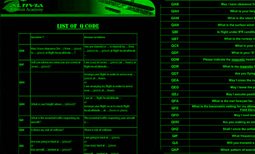 |
| QDM (Magnetic Bearing to a Station) | QDM represents the magnetic bearing to a radio navigation station. It assists in direction finding and route alignment during en-route or approach phases. | 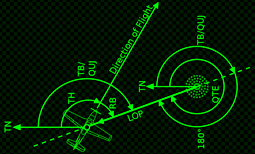 |
| QDR (Magnetic Bearing from a Station) | QDR is the magnetic bearing from a radio navigation station to the aircraft. It complements QDM and helps pilots determine their position relative to the station. | 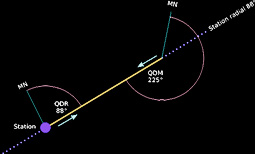 |
| Q-Factor (Navigation) | The Q-factor refers to the quality factor of a navigational signal, assessing its reliability and accuracy. It is critical in aviation to ensure precise GPS readings, particularly for approaches and landings in low-visibility conditions. | 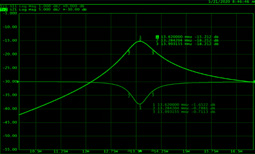 |
| QFE (Field Elevation Pressure) | QFE is the atmospheric pressure at an airport's elevation. When set on the aircraft altimeter, it displays height above the field level, useful for landing operations. It ensures accurate altitude readings relative to the runway during the approach. | 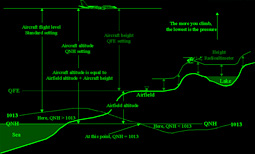 |
| QNH (Local Pressure Setting) | QNH is the atmospheric pressure adjusted to mean sea level at a specific location. Setting QNH on an aircraft’s altimeter ensures accurate altitude readings relative to sea level, essential for maintaining vertical separation. | 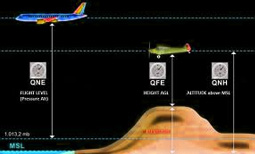 |
| Quadrant Identifier | A quadrant identifier is a designated airspace sector used by air traffic controllers to manage and direct aircraft. It simplifies navigation and traffic management by dividing airspace into easily recognizable areas. |  |
| Quadrant Navigation | Quadrant navigation involves dividing an area into four sectors for route planning and air traffic management. This method is particularly useful in busy airspaces to ensure efficient traffic flow and conflict resolution. | 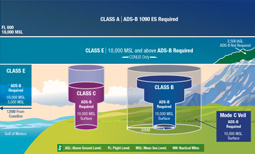 |
| Qualification Check | A qualification check is a mandatory assessment for pilots to verify their proficiency and compliance with aviation regulations. It includes simulator tests, practical flight evaluations, and knowledge exams to ensure operational readiness. | 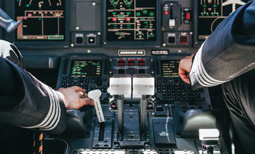 |
| Qualified Pilot Examiner (QPE) | A QPE is an authorized individual responsible for conducting pilot proficiency checks and issuing certifications. They evaluate a pilot’s skills, knowledge, and adherence to regulations during flight or simulator tests. | 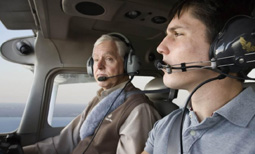 |
| Quantum Radar (Aviation) | Quantum radar is an emerging technology that uses quantum mechanics to enhance radar detection. It promises improved sensitivity and resistance to electronic jamming, making it valuable for military and civilian aviation. | 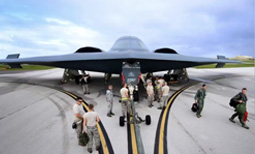 |
| Quantum Sensor | Quantum sensors in aviation use quantum technology to measure physical phenomena such as gravitational fields or magnetic forces. They improve navigation accuracy, particularly in GPS-denied environments or challenging conditions. |  |
| Quarantine Procedures (Aviation) | Quarantine procedures ensure the isolation of aircraft, passengers, or cargo exposed to infectious diseases or pests. These measures prevent the spread of harmful agents and comply with international health regulations. | 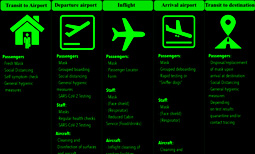 |
| Quasi-Steady Flight | Quasi-steady flight refers to a flight condition where an aircraft maintains a nearly constant speed, altitude, and attitude. It is ideal for fuel-efficient cruising and minimizes wear on aircraft systems. | 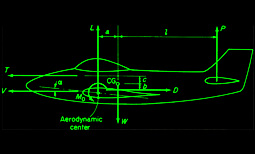 |
| Quick Access Recorder (QAR) | A QAR is a device that records flight data for operational analysis and safety monitoring. Unlike a black box, its data is easily retrievable for quick review by maintenance and safety teams. | 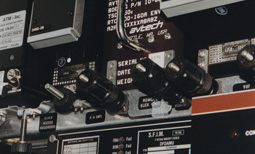 |
| Quick Donning Mask | A quick-donning mask is an oxygen mask designed for pilots, enabling rapid deployment in emergencies. It ensures immediate oxygen supply during cabin depressurization or smoke events. |  |
| Quick Reference Handbook (QRH) | The QRH is a cockpit manual containing essential procedures for abnormal or emergency situations. Pilots use it to quickly access step-by-step instructions, ensuring timely and accurate responses. | 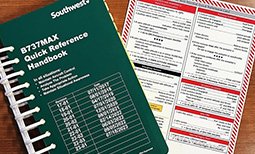 |
| Quiet Supersonic Technology (QST) | QST is a cutting-edge development in aircraft design aimed at reducing the sonic boom impact of supersonic travel. This technology enables faster-than-sound travel while minimizing environmental and noise pollution. | 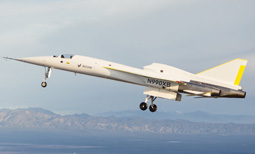 |
| Quiet Taxi Operations | Quiet taxi operations involve minimizing engine noise during taxiing by using electric ground power units or low-thrust settings. These practices enhance airport noise management and fuel efficiency. | 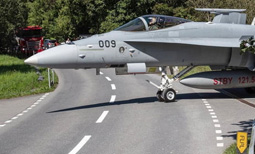 |
| Quill Shaft (Engine Component) | A quill shaft is a flexible coupling used in aircraft engines to absorb torsional vibrations between components. It protects the engine and transmission systems from damage caused by mechanical stress. |  |
| Q-Pole (Magnetic Navigation) | The Q-pole represents a theoretical magnetic point used in navigation to calibrate instruments or align with specific magnetic fields for directional accuracy. | 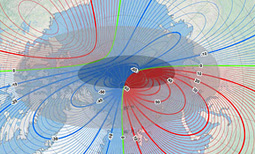 |
| QTE (True Bearing to a Station) | QTE is the true bearing from an aircraft to a navigation station. It helps pilots and navigators determine their exact position relative to a ground-based beacon. | 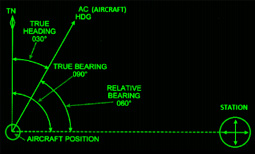 |
| QTF (True Bearing from a Station) | QTF is the true bearing from a navigation station to an aircraft. It is complementary to QTE and aids in precise navigation and situational awareness. | 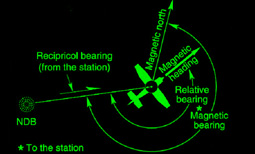 |
| Quality Assurance in Maintenance | Quality assurance in aviation maintenance ensures that all repairs, inspections, and modifications meet regulatory and manufacturer standards. It is critical for operational safety and compliance. |  |
| Quality Management System (QMS) | A QMS in aviation oversees processes to maintain high safety, efficiency, and service standards. Airlines and maintenance facilities use QMS to ensure consistent operational quality. | 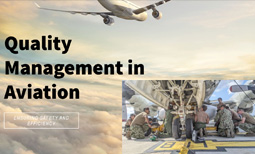 |
| Quartering Headwind | A quartering headwind strikes the aircraft from a forward diagonal direction. It affects takeoff, landing, and taxi operations, requiring pilots to adjust control inputs for stability. | 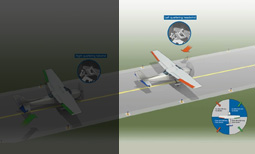 |
| Quartering Tailwind | A quartering tailwind strikes the aircraft from a rear diagonal direction. It increases ground speed during landing and takeoff, potentially reducing control effectiveness and requiring pilot compensation. | 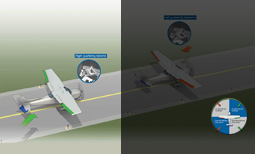 |
| Quenching (Metalwork in Aircraft) | Quenching involves rapidly cooling metals to enhance their hardness and durability. It is commonly used in aircraft manufacturing to improve the structural strength of components. | 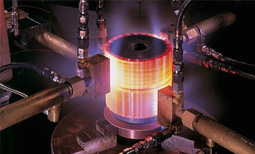 |
| Quiescent Flight | Quiescent flight refers to steady-state conditions with minimal turbulence or disturbances. It allows for optimal fuel efficiency, stable navigation, and passenger comfort. | 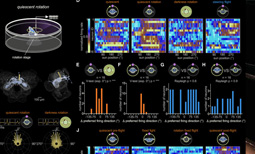 |
| Quiet Runway Operations | Quiet runway operations reduce noise impact by implementing procedures like optimized flight paths, continuous descent approaches, and restricting late-night departures. |  |
